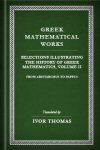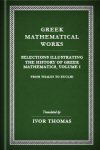Greek Mathematical Works Collection (4 vols.)
Digital Logos Edition
Overview
A hallmark of ancient Greek thought is the development of mathematics. Greek mathematics are the foundation upon which all modern-day math is based. The names of ancient mathematicians are still interwoven with their discoveries—Euclidean geometry, the Pythagorean Theorem, and the Archimedean Axiom, testifying to the significance of mathematics’ Greek origins. Selections Illustrating the History of Greek Mathematics is a compilation of texts about the development of Greek mathematics. Translator and compiler Ivor Thomas draws from the works of Greek mathematicians and historians. This compilation furnishes a complete picture of the rise of Greek mathematics. It's of value both to classics scholars and to mathematicians seeking to understand the origins of their study.
This collection contains the complete texts in their Loeb Classical Library editions. Each text is included in its original Greek, with an English translation for side-by-side comparison. Use Logos’ language tools to go deeper into the Greek text with linked translations, definitions, and pronunciation tools. You can also use the dictionary lookup tool to examine difficult English words. Quick and easy access to definitions and lexical information allows you to understand Greek mathematics like never before.
This title is included in the following collections
You can save when you purchase this product as part of a collection.
Loeb Classical Library Builder...
$1,269.18$508.99Classic Catholic Scholarship C...
$3,413.99$3,413.99Classic Scholarship Collection...
$12,102.39$7,299.99

Key Features
- Selections from works by Greek mathematicians and historians, detailing the foundations of modern mathematics
- Proofs and theorems, accompanied by diagrams
- Extensive footnotes providing useful commentary on the development of foundational mathematical theorems
- Loeb Classical Library editions
Product Details
- Title: Greek Mathematical Works Collection (4 vols.)
- Translator: Ivor Thomas
- Series: Loeb Classical Library
- Publisher: Harvard University Press
- Volumes: 4
- Pages: 1,252
Individual Titles
This volume contains Ivor Thomas’ English translations of texts about Greek mathematics ranging from the sixth to the fourth century BC.
Featured in volume 1 are Pythagorean arithmetic and geometry, Thales’ theorems of geometry, Aristotle’s iconic principle of the lever, and Zeno of Elea’s theories of motion. Also included are Democritus’ expressions for the volume of cones and pyramids, Hippocrates of Chios’ research on the quadrature of the circle, Theaetetus’ descriptions of solids, and Eudoxus of Cnidos’ theories of proportions and spheres. The volume concludes with Euclid’s elements of geometry.
This volume contains the Greek language selections about Greek mathematics ranging from the sixth to the fourth century BC.
Featured in volume 1 are Pythagorean arithmetic and geometry, Thales’ theorems of geometry, Aristotle’s iconic principle of the lever, Zeno of Elea’s theories of motion. Also included are Democritus’ expressions for the volume of cones and pyramids, Hippocrates of Chios’ research on the quadrature of the circle, Theaetetus’ descriptions of solids, and Eudoxus of Cnidos’ theories of proportions and spheres. The volume concludes with Euclid’s elements of geometry.

Selections Illustrating the History of Greek Mathematics, vol. 2
- Translator: Ivor Thomas
- Series: Loeb Classical Library
- Publisher: Harvard University Press
- Publication Date: 1941
- Pages: 356
This volume contains Ivor Thomas’ English translations of texts about Greek mathematics ranging from the third century BC to the fourth century AD.
Featured in volume 2 are Aristarchus of Samos’ theories of the distance of the sun and the moon, Archimedes’ discoveries in mechanics, Eratosthenes’ mathematical measurement of the Earth, and Apollonius of Perga’s developments in geometry. Also discussed are Ptolemy's table of sines, Heron of Alexandria’s measurement of areas and volumes, and Pappus of Alexandria’s revival of geometry.

Selections Illustrating the History of Greek Mathematics, vol. 2: Greek Text
- Translator: Ivor Thomas
- Series: Loeb Classical Library
- Publisher: Harvard University Press
- Publication Date: 1941
- Pages: 356
This volume contains the Greek language selections about Greek mathematics ranging from the third century BC to the fourth century AD.
Featured in volume 2 are Aristarchus of Samos’ theories of the distance of the sun and the moon, Archimedes’ discoveries in mechanics, Eratosthenes’ mathematical measurement of the Earth, and Apollonius of Perga’s developments in geometry. Also discussed are Ptolemy's table of sines, Heron of Alexandria’s measurement of areas and volumes, and Pappus of Alexandria’s revival of geometry.
Reviews
6 ratings


M. David Johnson
3/27/2015

Peggy
2/24/2015

Dave Crosby
1/26/2015

Larry Proffitt (I
1/3/2015

Allen Bingham
12/30/2014

